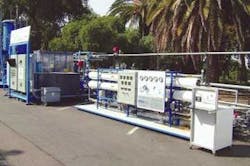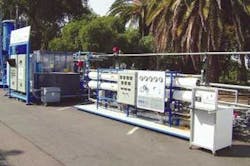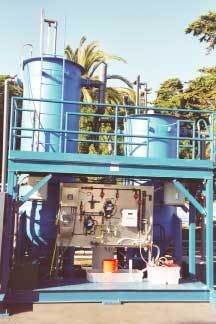By Nikolay Voutchkov
In response to the drive for local drought-proof water resources to supplement Southern California's traditional water supply alternatives, Poseidon Resources is advancing the development of several large seawater desalination plants, including projects in the City of Huntington Beach and Carlsbad, CA.
The two desalination plants would be located at existing coastal electrical power generation stations. The Huntington Beach and Carlsbad desalination plants are projected to have product water capacity of 50 mgd each. The two projects are in a process of environmental feasibility review and permitting, and are planned to begin construction within two years.
To demonstrate the feasibility of coastal desalination and the benefits of co-location of large desalination plants with existing power plants in Southern California, Poseidon Resources assisted by a local specialty contractor (Enaqua) and Hydranautics, have constructed a 20 gpm desalination demonstration plant located at the Encina Power Plant in Carlsbad.
This seawater desalination demonstration facility consists of a raw water intake feed pump station; two pretreatment filtration systems configured to operate in parallel; filtered water transfer pumps; membrane system feed seawater storage tank; 5-micron cotton cartridge filter; 45 gpm high-pressure reverse osmosis (RO) feed pump; a single-stage RO system; permeate lime conditioning system; and UV disinfection system.
The demonstration plant also has a potable water sampling station that allows visitors to taste the desalinated water. In addition, this facility is equipped with a number of ports for water quality sample collection. The demonstration plant is fully automated and is designed for remote monitoring and control via the internet.
The source of feed seawater for the planned full-scale plant and for the demonstration facility is the warm cooling water of the Encina power plant. This once-through power generation station withdraws cooling water from the Pacific Ocean via the Agua Hedionda Lagoon. After passing through the power plant intake structure, trash racks and traveling screens, the cooling water is pumped through the condensers of the power plant generation units.
The power plant has a total of five power generators and depending on the number of units in operation pumps between 200 mgd and 820 mgd of cooling water through the condensers. The warm cooling water from all condensers is directed to a common discharge tunnel and lagoon leading to the ocean. The full-scale desalination facility is planned to tap to this discharge tunnel for both desalination plant feed water and for discharging high-salinity concentrate downstream of the intake area.
The demonstration system intake withdraws warm water from a small lagoon which is located at the end of the power plant discharge tunnel. The power plant discharge cooling water is typically 5 to 10 degrees Fahrenheit warmer than the ocean seawater. Intake seawater's total dissolved solids (TDS) concentration varies between 33,000 milligrams per liter (mg/L) and 34,500 mg/L, and averages 33,500 mg/L. The demonstration plant's dry-weather intake water turbidity is usually between 1 and 4 nephelometric turbidity units (NTU). During wet-weather conditions, which are usually brief and occur mostly in the winter, raw seawater turbidity varies from 6 to 12 NTU, with occasional hourly spikes of up to 24 NTU.
The intake seawater is conveyed to a feed storage tank from where it is pumped to the demonstration plant pretreatment systems. Currently, the two pretreatment systems undergoing testing are Parkson's two-stage, continuous backwash granular media filtration system and Hydranautics' HydraSub© immersed microfiltration (MF) system.
The granular-media pretreatment system includes two Parkson Dynasand© continuous backwash filters in series. The first filter has a coarse (9mm) sand media bed. The second filter contains finer (5mm) sand media. Both filters have instrumentation for continuous turbidity monitoring and data logging. The second-stage filter is also equipped with a particle counter.
The microfiltration system consists of a test vessel which contains several immersed membrane modules and typically operates under less than 1 to 3 psi of vacuum. This system is also equipped with instrumentation for feed water and filtrate turbidity monitoring, and for automated data reporting and acquisition.
The two pretreatment systems are operated independently and typically produce between 40 and 45 gpm of filtered water each. The feed water to the granular media pretreatment system is conditioned using ferric sulfate. At this time, the MF system does not use chemicals for raw seawater conditioning and is tested at filter effluent production rates similar to these of the granular media system.
The reverse osmosis system consists of two 4-element pressure vessels in series. This RO system configuration allows permeate to be collected from one or both ends of each vessel and to test different numbers of membrane elements. The tested seawater reverse osmosis membrane elements are 8-inch diameter, high salt-rejection units provided by Hydranautics. The RO system is designed to run in a range of 45 to 55 percent recovery and typically operates at 50 percent recovery. The effects of operation at higher and lower than 50 percent recovery on key system parameters such as permeate TDS concentration, feed pressure and other parameters are planned to be tested over the course of the demonstration study.
The demonstration desalination plant has been in continuous 24-hours/day operation since August 2003. The quality of the produced permeate is consistently high - TDS concentration of 200 and 300 mg/L at RO system feed pressure between 780 and 900 psi. The two pretreatment systems are performing well and the filtered seawater of these systems typically has silt density index (SDI) of less than 4 and turbidity below 0.1 NTU.
In both the demonstration scale and the planned full-scale desalination plants, the high-salinity concentrate, which is a side product of the desalination process, is blended with the power plant cooling water discharge prior to discharge to the ocean. Chronic and acute whole effluent toxicity testing of a blend of demonstration plant concentrate and power plant cooling water in a ratio corresponding to a full-scale worst-case discharge conditions, indicates that the blended discharge is environmentally safe.
About the Author:
Nikolay Voutchkov has over 22 years of experience in the development, design, construction, startup and operation of municipal and industrial desalination facilities and water and wastewater treatment plants. Currently he is a Senior Vice President of Technical Services for Poseidon Resources Corporation. He may be contacted at e-mail: [email protected].





